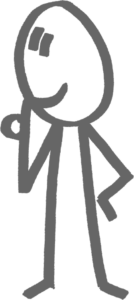







Zhi is an Agile Coach at Teamworx, an Agile Coaching and Training consultancy based in Auckland. A big part of his work is to help teams increase their flow through visualising their work. He works at Mercury, an Energy company in New Zealand.
Like many Visual Friends students, Zhi didn’t grow up loving drawing. “As a kid, I was never good at Art. In fact, I used to get D’s or C’s at Art classes.” Now Zhi is using visualisation techniques daily and even coaching others. It’s one of the most powerful tools in his Agile Coach toolkit.
Zhi saw Bikablo® in action by accident. At a strategy offsite he was attending, the scribe happened to be a Bikablo® practitioner. The simple and striking visual language piqued Zhi’s interest. At the time, he was already practising Sketchnoting, which is essentially processing information, distilling it, then expressing the concepts using a combination of simple imagery and visuals. “People seemed to enjoy meetings with sketching and were more involved.” However, seeing the Bikablo technique opened doorways for taking his practice further. Zhi was really keen to learn this visualisation language made such an impression. In 2018 there was an opportunity to attend a two-day Visual Friends course in Auckland, and Zhi jumped right in.
The self-taught technique of Sketchnoting had given Zhi a foundation for visual thinking. “The two days with Visual Friends allowed me to apply that background knowledge and sharpen my drawing technique. It was fantastic to have two days of practical experience.” Zhi found Bikablo® accessible and impactful at the same time. “One of the main principles was to simplify things to the max, and I learnt to use simple lines and shapes as opposed to stressing out about creating a perfect picture.” Zhi also credits the course with increasing his confidence to sketch in front of a group and facilitate a conversation. “People often comment on the quality of the drawings, they love it.”
New skills lead to new career opportunities. Zhi ran two major graphic recording sessions at his workplace. One was for a Finance team which invited him to scribe at their strategy off-site after seeing his work. “The typical stereotype of accountants is that they “by-the-book” and focused on numbers, instead of conversations. I felt that was not true when I started drawing and explaining the purpose of visualisation to the team. When they understood how useful it is to summarise key points and present them as a picture, when they saw graphic recording in action, they got really interested in the visual way of working.”
Video of the graphic recording at the Finance Offsite:

That experience was a special one for Zhi. “My work as an Agile coach is to teach people new ways of collaborating, new ways of visualising their work and how to have really good discussions. Visualisation has enabled me to do that outside of IT which has been a real highlight. “
Zhi’s most proud moment so far has been using the skills learnt through Visual Friends to record the history of his company, Mercury, at a recent event. He was invited to scribe at an offsite where the discussion evolved around the past, present and future of the geothermal fields (Mercury is an energy company and geothermal fields are one of the energy sources). Two long days, 16 hours of graphic recording and 20 meters of paper later, the scroll was complete.
“It was amazing to record our journey and put it to pictures. Ours is the company that really values NZ heritage and to be able to represent the history of the place, to see people being so engaged in the conversation was such an honour for me.” Zhi’s recording was laminated and sent to all of Mercury’s geothermal field sites around New Zealand. “We displayed the large sketches in the offices to make it easier to explain what each Geothermal field is about. It’s just amazing.” Zhi believes his visualisation contribution is enhancing the way teams work at his workplace. “My scribing for the Finance department is a good example of how visual culture is slowly becoming not just an Agile and IT thing. Lots of other departments have become interested in visual ways of working.”
Zhi is confident using visualisation is going to enhance the way organisations communicate. “Visualisation makes the connection so much richer as opposed to talking to someone or reading a message off a list. People perceive the message better. You can have a better-quality conversation.” You can find out more about Zhi’s work here.

The article was written by Natalia Tsygankova. Natalia has always loved words and talking to people. She has put that passion to good use and has been sharing people’s stories in the community radio, TV and print media for the last 10 years. Natalia is also a big fan of true storytelling events and regularly volunteers at the most famous one – The Moth, interviewing the winner. You can hear her own story of moving to Australia from Russia in 1999 here. Natalia believes that everyone has a story – So what’s yours? Contact her today to share your story.

